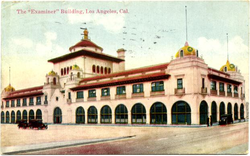Los Angeles Herald Examiner
| Los Angeles Herald Examiner Building | |
|---|---|
 |
|
| Location | 146 W. 11th Street, Downtown Los Angeles. |
| Designated | 18 August 1977 |
| Reference no. | 178 |
The Los Angeles Herald Examiner was a major Los Angeles daily newspaper, published Monday through Friday in the afternoon and in the morning on Saturdays and Sundays. It was part of the Hearst syndicate. The afternoon Herald-Express and the morning Examiner, both of which had been publishing in the city since the turn of the 20th century, merged in 1962. For a few years after this merger, the Herald Examiner claimed the largest afternoon-newspaper circulation in the country.
It published its last edition on November 2, 1989.
William Randolph Hearst founded the Los Angeles Examiner in 1903, in order to assist his campaign for the presidential nomination on the Democratic ticket, complement his San Francisco Examiner, and provide a union-friendly answer to the Los Angeles Times. At its peak in 1960, the Examiner had a circulation of 381,037. It attracted the top newspapermen and women of the day. The Examiner flourished in the 1940s under the leadership of City Editor James H. Richardson, who led his reporters to emphasize crime and Hollywood scandal coverage.
The Herald Examiner was the result of a merger with the Los Angeles Herald-Express in 1962. And the Herald-Express was the result of a merger between the Los Angeles Evening Express and Evening Herald in 1931. The Herald-Express was also Hearst-owned and excelled in tabloid journalism under City Editor Agness Underwood, a veteran crime reporter for the Los Angeles Record before moving to the Herald-Express first as a reporter and later its city editor.
The Examiner, while founded as a pro-labor newspaper, moved to the far right over the decades. It was pro-law enforcement and was vehemently anti-Japanese during World War II. Its editorials openly praised the mass deportation of Mexicans, including U.S. citizens, in the early 1930s, and was hostile to liberal movements and labor strikes during the Depression. Its coverage of the Zoot Suit Riots in Los Angeles during World War II also was particularly harsh on the Mexican-American community.
Much of its conservative rhetoric was minimized when Richardson retired in 1957. Underwood remained on staff following the merger in an upper management position, leaving the day-to-day operations to younger editors.
...
Wikipedia
